'Not a single bullet was fired, but we were warning the enemy not to continue with their antics!'
IAF Veteran Air Commodore Nitin Sathe finds out how the Light Combat Helicopter, which will be inducted into the IAF on October 3, was designed, developed and flown.
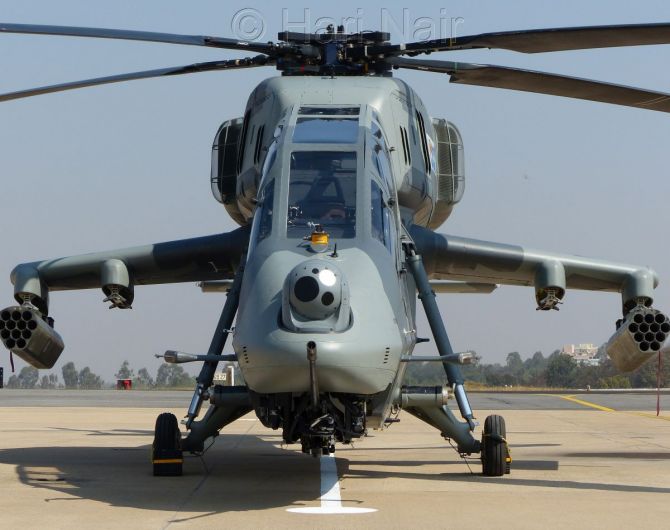
On a trip to the Hindustan Aeronautics Limited in Bengaluru a few years ago, I bumped into helicopter pilot pals from the Indian Air Force who were part of the task force helping India produce its first Light Combat Helicopter.
The thrilling part of the visit was a glimpse into the cockpit and a chat with my dear friend, Veteran Group Captain Hari 'Harry' Nair, one of the lead flying members of this important project.
As Harry showed me around the cockpit and answered the thousand questions I had for him, he asked me, "I say Sathe ol' chap! Can you help me with something? You see..."
He went on to explain to me some of the system switches that were being installed in the cockpit and wanted information on the ergonomics of the Mi-35 cockpit which I was familiar with.

The question thrilled me no end and I went on to tell him a lot more than he wanted to hear. But hear me patiently he did, and thanked me for the inputs.
I somehow felt that I had contributed my little bit in the making of the first indigenous attack helicopter of our nation!
All that was forgotten till a few days ago when I read about the LCH in the news.
The aircraft was soon to become part of the IAF inventory with 6 machines handed over to the new unit being raised at Jodhpur in the western sector.
Getting an aircraft from the drawing board into the air is no mean task.
Ask any test pilot and he will tell you what all goes behind taking a new machine into the air and proving it fit for operational use.
I decided to speak with a few to find out.
The first of the attack helicopters, the Mi-25 (NATO name HIND) arrived in India in 1984 from Russia and they were extensively used in the operations against the LTTE in Sri Lanka.
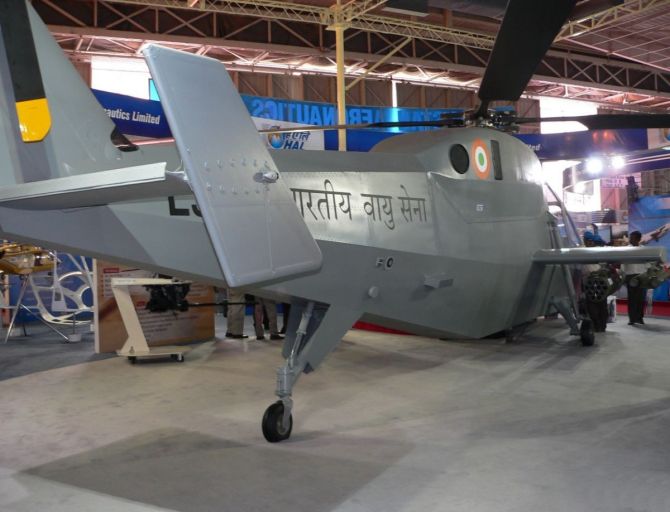
In 1989, the first of the upgraded Mi-25, named the Mi-35, augmented this fleet and we now had two squadrons of these versatile machines operating with the army mainly in the anti-tank role and with the IAF in some specialised roles.
These helicopters are now on their last leg having served more than three decades.
Very recently, the Apache helicopter from the US has become part of the offensive arm and is operational in two squadrons of the IAF.
Ever since the Kargil conflict of 1999, it was felt that the armed forces needed a machine that could operate at high altitudes so that our forces guarding our northern borders could get the necessary armed support.
The Mi-35, or for that matter the Apache too (we didn't have it then) wasn't capable of operating at those altitudes; and, as an ad-hoc measure, the armed version of the medium lift helicopter-the Mi-17 was used in this conflict.
The experts on warfighting have always felt that if we had a versatile attack helicopter in 1999, we would have pushed out the Pakistani intruders with lesser loss of lives and in an earlier timeframe.
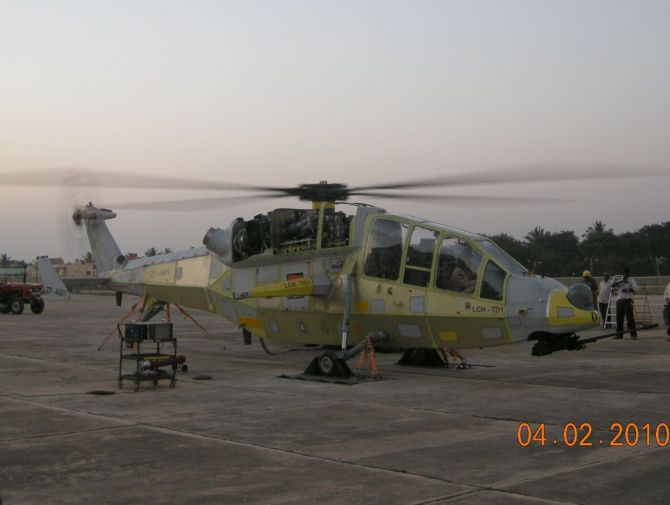
The IAF spelt out the air staff qualifying requirements (GSQRs or ASQRs as they are called) for such a machine as early as 2003 and worked with the Hindustan Aeronautics Limited at Bangalore exploring possibilities of producing our own attack helicopter.
"I was posted at the Aircraft Systems Testing Establishment (ASTE) at Bangalore then, and was the go-between HAL and Air Headquarters during the ASQR phase, when the IAF's requirements for the LCH were being finalised," Harry tells me.
"After a brief tenure out of ASTE later, I was back at HAL when the project was just about taking off."
The next few years was hectic and interesting too.
The basic design of the new machine was being 'borrowed' from the already operational Advanced Light Helicopter (ALH) -- the Dhruv -- and everyone thought it would be easy.
"I remember there was this amazing aerodynamics expert and designer, Mr B P Rao, whose first design came in for a bit of critique for being rather tubby."
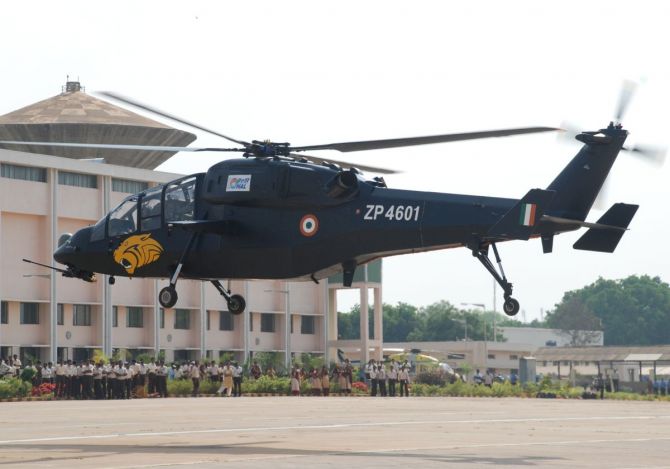
Mr Rao was a quick thinker and worked relentlessly on the design all over again.
To cut down the flab, what the experts did was to take a radius of 18 inches around the pilot's head in the cockpit and shave off the rest of the curved design to make it sleek, almost like what you see today.
With all the trimmings that were done, we finally had a sleek looking tandem seater helicopter which was what the IAF had asked for.
"Designing a new aircraft becomes more difficult when we do not have the sophisticated fundamental design infrastructure as is available in the US and Europe," says Harry.
"Here, they have large scale wind tunnels where fairly large aircraft models can be tested at speeds of 200 knots (360 kmph) or more and the data so gathered after these tests drastically reduces the flight testing effort."
"So, in our case, the testing becomes more cumbersome, time consuming and costly too. It is almost like a game of hit and trial; well almost so!"

"Wing Commander Unni Pillai and I first flew the LCH-TD1 (Technology Demonstrator-1) on March 29, 2010. But before that, there were so many tests of running the engines and systems on ground which took almost five months," Harry recalls.
"The aircraft had sophisticated telemetry equipment on board which transmitted various parameters of the airframe, engines and the systems to a team of senior designers sitting in a room with large screens in front of them akin to what you see for a launch of a satellite!"
"The aircraft initially flew well and handled well, but for high vibrations during hard manoeuvres. These vibrations were caused due to low torsional (twisting) stiffness of the cockpit area, that was subsequently corrected in a very major design analysis and re-manufacturing effort!" Harry points out.
"Telemetry is extremely good in forecasting immediate problems. However, for obvious reasons there is a limit to its capabilities. One day, while Unni was testing the aircraft near the ground making it go in circles at a turn rate of almost 60 degrees per second, the helicopter spun out of control; There was just no time for the Telemetry control to interject or advise. Unni, an ace pilot, was quick enough to bounce the aircraft off the ground a couple of times to reduce the rotation and control it."
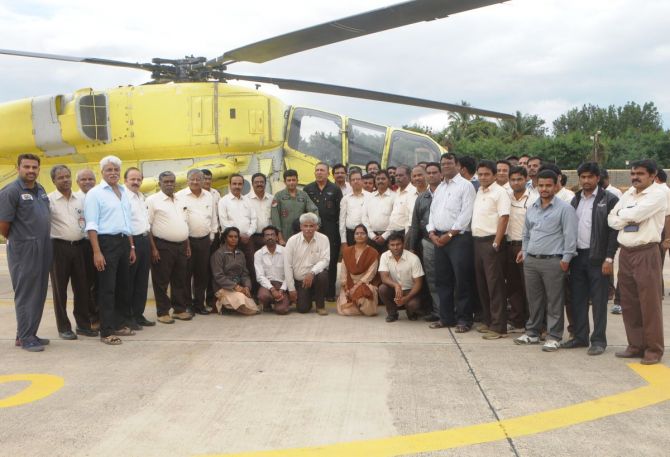
"In another instance, during a display at the Aero India 2011 at Yelahanka near Bangalore, when Unni and I were flying the demonstration, we heard grating sounds akin to heavy machinery being moved. We discontinued manoeuvres and landed back prematurely."
"We thereafter, gingerly flew TD-1 back to the factory where the designers found that three out of four support structures holding the main gear box had developed severe cracks."
"Both these incidents could have led to a catastrophic accident and would have led to the end of the development programme. Thankfully, good piloting skills, instinct, luck and God saved our day!"

It is necessary to test the aircraft in differing weather conditions and see that it meets the unique requirements of our country as well as its systems bear the vagaries of extreme weather.
Once the basic helicopter airframe was declared fly-worthy, it was time for hot and cold weather trials.
"We have conditions of +35 degrees at altitudes in Leh during summers and 45 plus degrees in the deserts of Rajasthan. The aircraft also had to undergo cold weather trials at high altitude in the Siachen Glacier area," says Harry.
Flying in the extremes of weather was demanding to say the least. They flew in the high reaches of the Himalayas in strong winds, blizzards and almost nil visibility.

In the desert, with temperatures in the high forties, it was difficult to even touch the skin of the aircraft when it "soaked" in the sun.
"A chase aircraft, a Mk-III ALH -- affectionately nicknamed by us as the 'overpowered little monster' -- initially followed us closely during cross-country flights, for external observations, advice and safety."
"At the back of our minds, we knew that if something were to go wrong, our comrade test crew in the Mk-III with its huge thrust margin would always pluck us away to safety even from extreme high altitude terrain, and that gave us additional confidence to fly this machine in trying conditions!"
Landing at small godforsaken helipads at altitudes above 16,000 feet, flying in dust storms and landing in a dust bowl where visibility went down to naught was gruelling, both for the man and the machine.
"And when we landed at these remote locations, we were always welcomed with a refreshing cup of tea and snacks and met our army jawans who guard our frontier. They were intrigued seeing a 'different' looking machine in their midst, and when they were told what we could do, the smiles on their faces said it all!
"The aircraft proved itself remarkably well in all conditions."

Whilst in the IAF, for reasons of pilot fatigue and safety, training flying comes to a halt when certain temperature and other weather parameters are exceeded, but here, the aircraft needed to be taken through these extreme conditions.
"The LCH has a fantastic air-conditioner suited for all the conditions that prevail in our country. This sure was a blessing in disguise since it reduced the fatigue factor to a great extent."
When Harry said this, I was reminded of the air conditioning in some of the Russian aircraft of yesteryears, in which the climate control switch in the aircraft had three positions: 'Hot'; 'Hotter'; 'Hottest'!
I asked Harry to take me through the process of birth of a new flying machine.
"After the user puts forward his qualifying requirements based on the operational necessities, the preliminary design requirements are drawn up by the company. The negotiations between the user and the manufacturer now begin so as to 'freeze' the requirements."
This is a difficult phase since the user wants the best technology, the best performance and at the lowest cost.
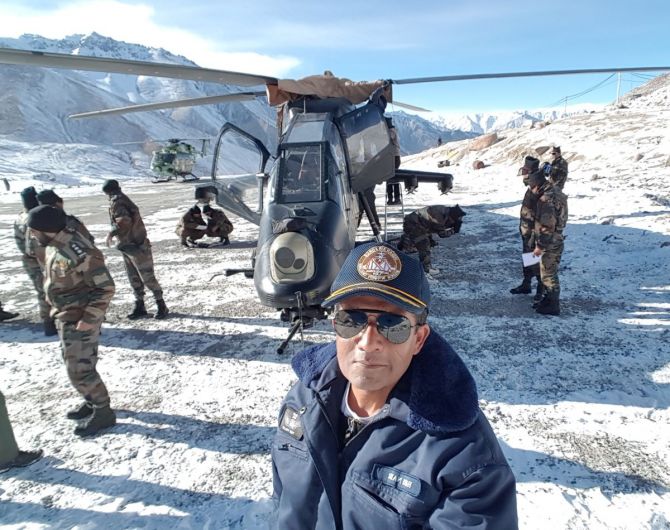
Some of the technologies asked for are not even available in the open market not only due to the cost, but because of the secrecy in its design and development.
"After this, the next phase is the Critical Design Review (CDR). Here, both sides go deeper into the requirements and kind of seal the deal based on which the first of the prototype is built."
As explained earlier in this article, the prototype may take months and years to get tested on ground before it takes to the air for the first time.
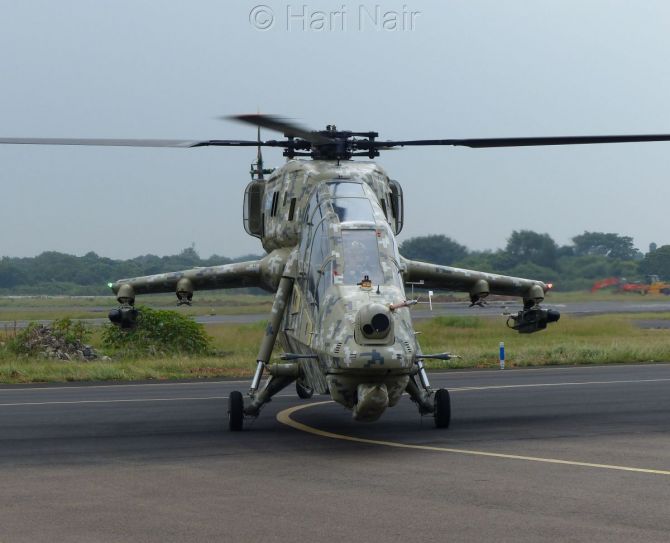
Once a certain degree of air-worthiness is achieved, the manufacturer makes three or four prototype aircraft called the technology demonstrators (TDs) which are flown extensively and dedicated to different kinds of testing.
"In our case, HAL went on to produce four prototypes; the first three funded by the defence forces and the fourth by the company itself. We flew close to 2,000 hours on these to prove the machine over the next few years," says Harry.
"The avionics suites, the armament, self-protection suites etc were finalised during these trials and we have finally gone into what is called the Limited Series Production-The LSP which is being handed over to the IAF."
"Everything in aircraft design and development is a calibrated and laborious process," Harry explains.
"First the aircraft is only cleared to hover, then it graduates on to gentle flying and when the design engineers are happy with the basic performance, the aircraft goes up to its max capability in small baby steps."
"At every stage when a problem is encountered, the designers, engineers and technicians are back on the machine, sometimes stripping it to the bone."
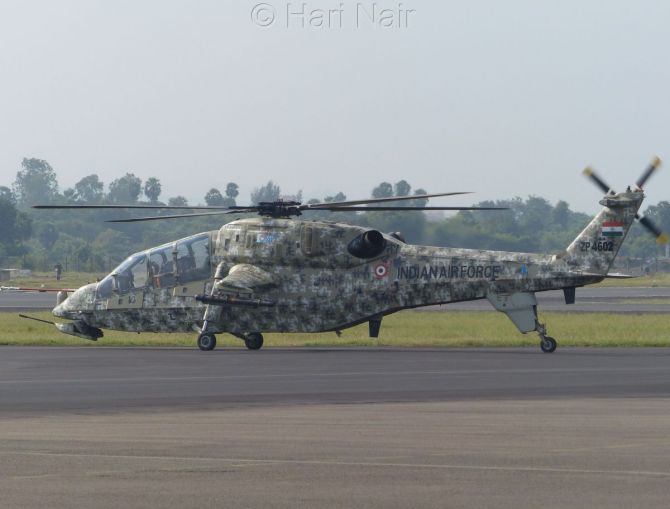
The total cost of the project has been Rs 3,887 crores (Rs 38.87 billion), of which Rs 377 crores (Rs 3,77 billion) have been utilised for infrastructure build up. The cost of the technology demonstrator is about Rs 126 crores (Rs 1.26 billion) a piece.
"As we produce more and more, the cost obviously will come down," says Harry.
A follow on order of about 150 LCHs are expected from the Indian Army and the IAF. Of these, 90 odd will be for the army and the rest for the IAF.
HAL has produced nine of the ten aircraft on order for the IAF which are being flown to Jodhpur to be handed over to the IAF squadron.
Another order for five more for the rmy will be met thereafter, and the army and IAF will fly these machines in their squadrons.
The feedback from the operators will help the manufacturer carry out necessary minor changes and modifications which will be incorporated in the series production once the LSP is declared battleworthy by the users.
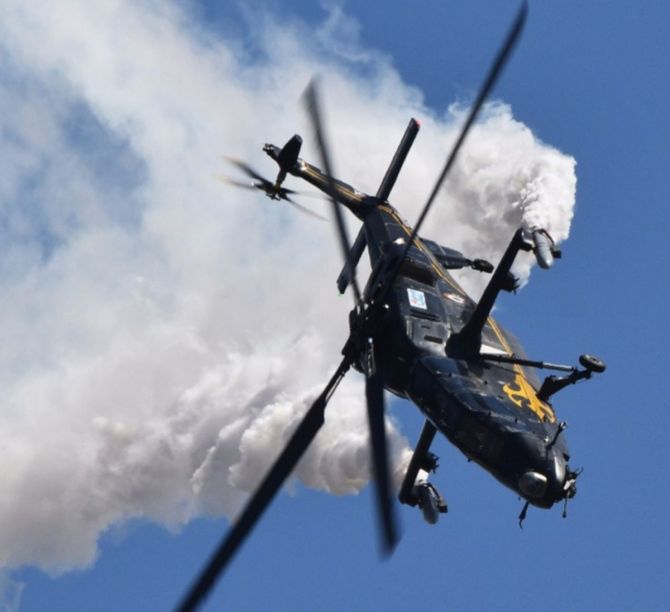
During the Ladakh standoff, HAL and IAF personnel were right there flying hot and high altitude flights.
HAL, on a request from the IAF, readily agreed to deploy the aircraft to patrol the Line of Actual Control in support of our troops with a combined crew of IAF and HAL test pilots.
"Our LCHs were exposed to battle conditions early in its life and this episode was a learning experience for all. Not that a single bullet was fired, but we were a show of force to the enemy, warning them not to continue with their antics!"
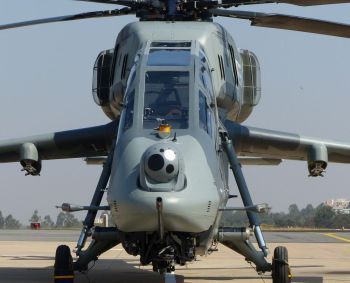
Air Commodore Nitin Sathe retired from the Indian Air Force in February 2020 after a distinguished 35 year career.
The author of three books, you can read Air Commodore Sathe's earlier articles here.
Feature Presentation: Rajesh Alva/Rediff.com









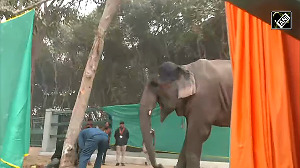

 © 2025
© 2025